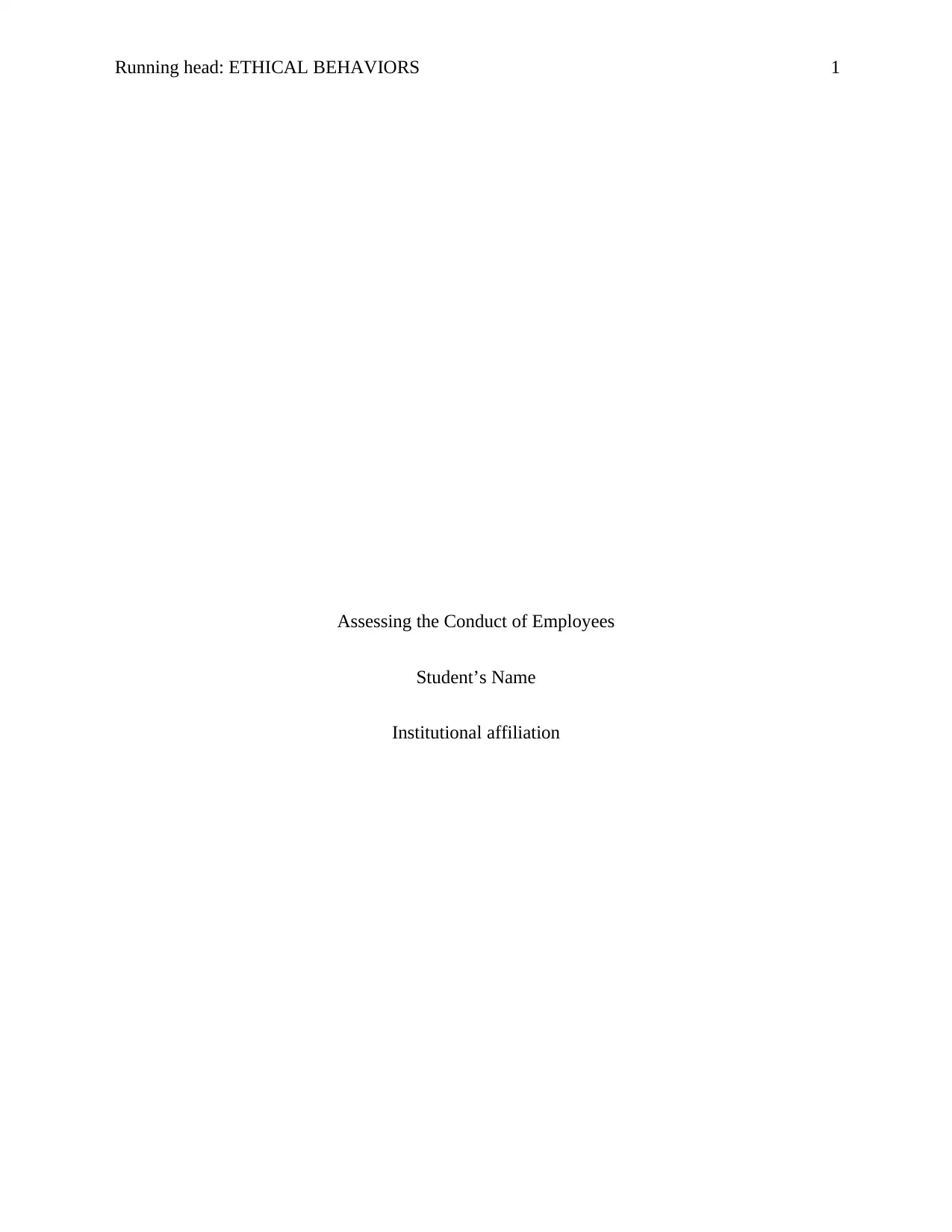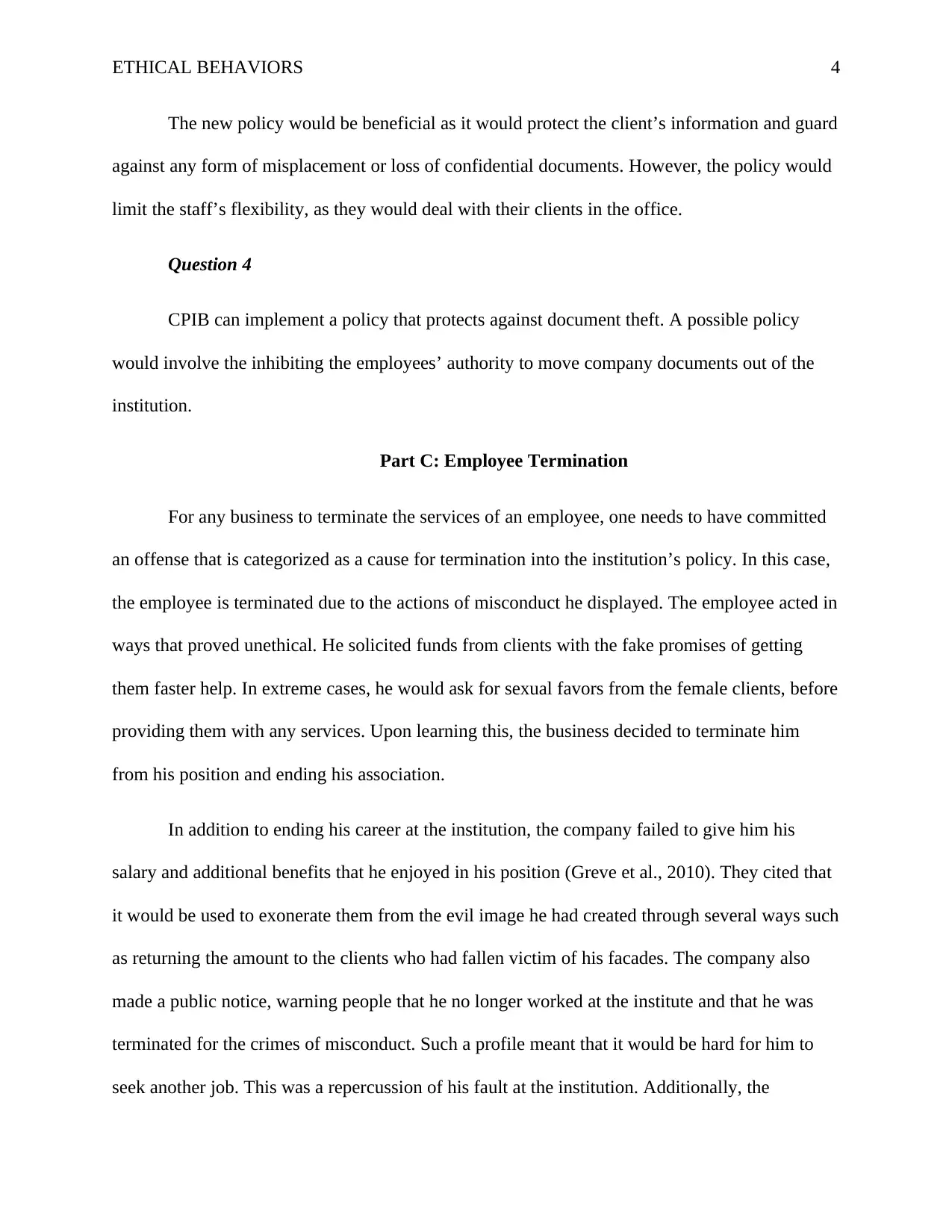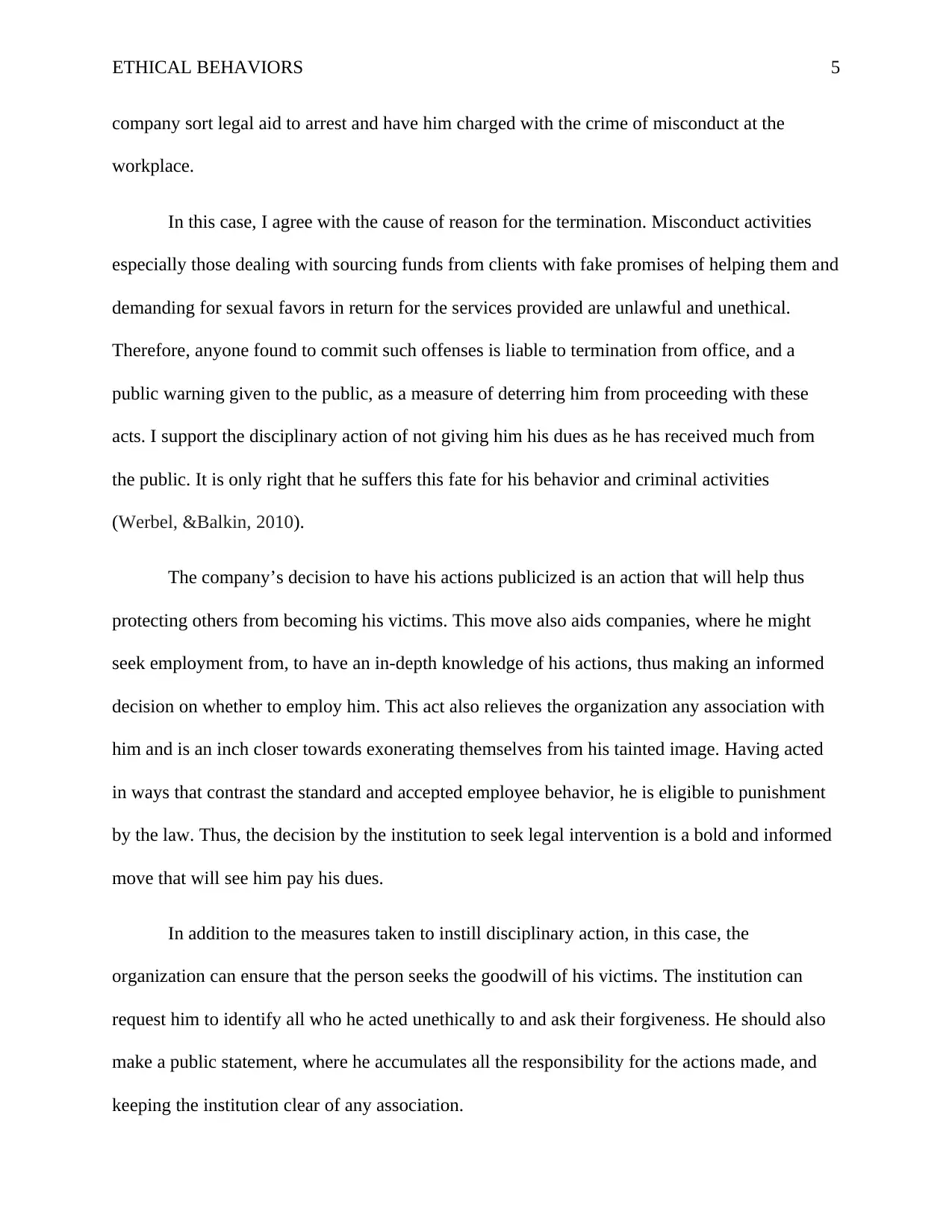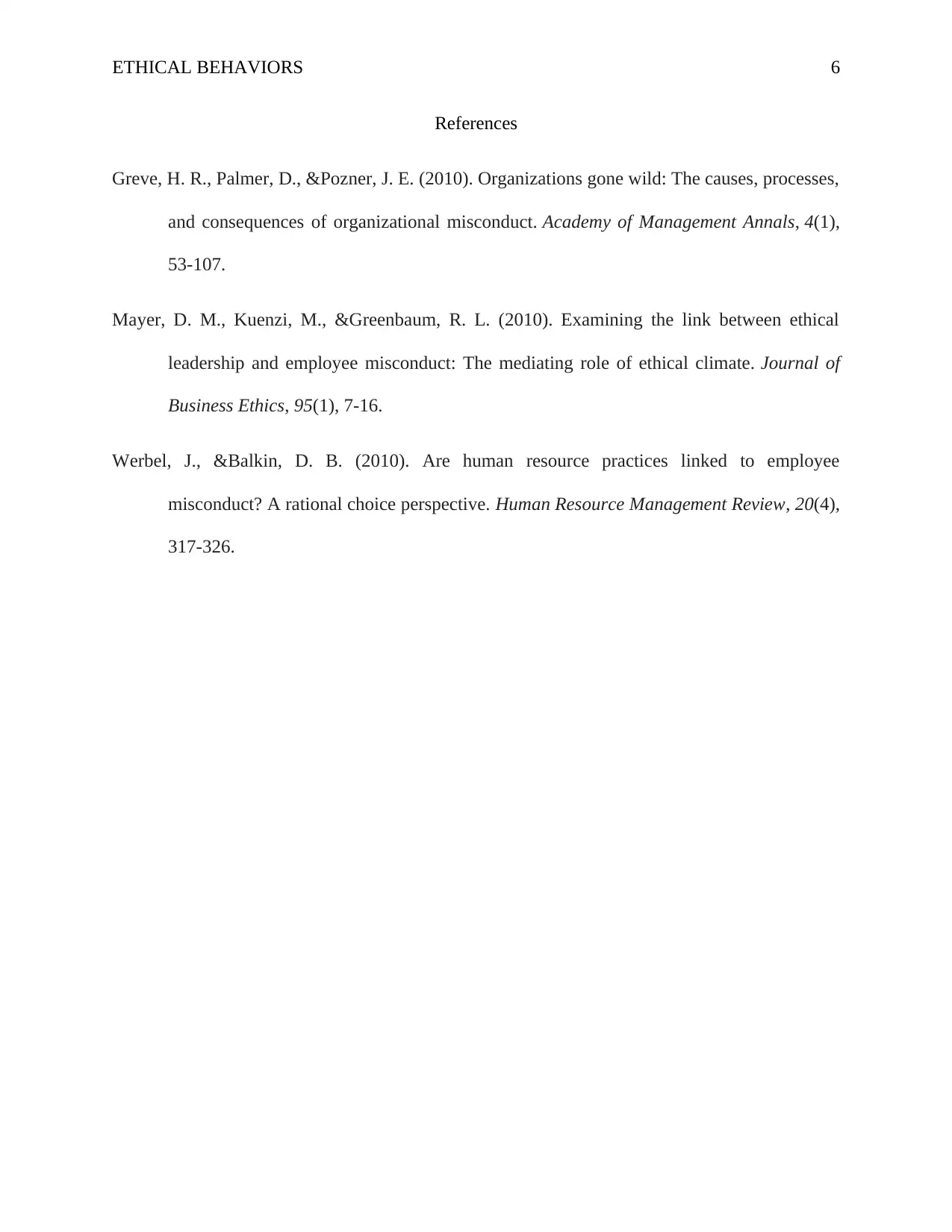HRM Assignment: Analyzing Ethical Behaviors Through Case Studies
VerifiedAdded on 2023/06/14
|6
|1311
|134
Case Study
AI Summary
This assignment presents a comprehensive analysis of ethical behaviors and employee conduct within an organizational context, utilizing case studies to explore various scenarios. Part A addresses employee relations issues, including sexual harassment, fraud, and unethical conduct, recommending appropriate actions and policy development. Part B focuses on security matters, analyzing the implications of policy violations and proposing new policies to protect confidential information. Part C delves into employee termination, evaluating the justification for termination based on misconduct and discussing the ethical and legal considerations involved. The assignment emphasizes the importance of upholding ethical standards, implementing effective HR policies, and ensuring fair and consistent disciplinary processes within the workplace. The document is available on Desklib, a platform offering a range of study tools and resources for students.

Running head: ETHICAL BEHAVIORS 1
Assessing the Conduct of Employees
Student’s Name
Institutional affiliation
Assessing the Conduct of Employees
Student’s Name
Institutional affiliation
Paraphrase This Document
Need a fresh take? Get an instant paraphrase of this document with our AI Paraphraser

ETHICAL BEHAVIORS 2
Part A: Case Studies
Addressing Employee Relations
Question 1
Britney is tasked with handling three difficult issues. However, the most crucial one is
one that involves the sexual advances directed towards Natalie, as it is in the public domain, and
thus she needs to restore the company’s reputation (Meyer et al., 2010). The second important
issue to handle is the case displaying fraud activities in the company. Lastly, Britney can deal
with the unethical conducts portrayed by Max.
Question 2
Joan violated the company’s policy, which advocated for the maintenance of privacy in
the organization. Britney can reprehend Joan for lashing out and informing all about the incident
of Natalie, which makes the company vulnerable. I would ensure that there are severe
repercussions for anyone who violates the communication policy (Greve et al., 2010)
Question 3
Max uses company assets to visit pornographic sites. This is an illegal act according to
the company’s laws. Britney can deal with this situation by restricting Max from accessing the
company’s facilities for a period.
Question 4
The company can develop a policy that control’s internet use. Such include the
installation of trackers that control a person’s actions when using the internet. This will aid build
the beneficial use of the internet.
Part A: Case Studies
Addressing Employee Relations
Question 1
Britney is tasked with handling three difficult issues. However, the most crucial one is
one that involves the sexual advances directed towards Natalie, as it is in the public domain, and
thus she needs to restore the company’s reputation (Meyer et al., 2010). The second important
issue to handle is the case displaying fraud activities in the company. Lastly, Britney can deal
with the unethical conducts portrayed by Max.
Question 2
Joan violated the company’s policy, which advocated for the maintenance of privacy in
the organization. Britney can reprehend Joan for lashing out and informing all about the incident
of Natalie, which makes the company vulnerable. I would ensure that there are severe
repercussions for anyone who violates the communication policy (Greve et al., 2010)
Question 3
Max uses company assets to visit pornographic sites. This is an illegal act according to
the company’s laws. Britney can deal with this situation by restricting Max from accessing the
company’s facilities for a period.
Question 4
The company can develop a policy that control’s internet use. Such include the
installation of trackers that control a person’s actions when using the internet. This will aid build
the beneficial use of the internet.

ETHICAL BEHAVIORS 3
Question 5
Yes, Paul should be dismissed. One the company’s policy is honesty and integrity
(Werbel, &Balkin, 2010), both of which he acted in contrasting ways. His failure of reporting the
crime is a just base for his termination.
Question 6
If the court finds the organization as having no just cause to terminate Paul, the
organization’s reasonable notice would be to suspend him for a period. This would help control
further legal complications arising from the issue.
Question 7
If I were in Paul’s position, I would have reported the case to senior management. This is
because I would have witnessed an unethical act, and thus requiring me to report to the
administration for further follow-up.
Part B: A Matter of Security at Canadian Pacific and International Bank
Question 1
I would recommend a disciplinary action. It was negligent of her to take the property out
of the office and not employ cautious steps to ensure that it is safe.
Question 2
There are long-term implications for the human resources. The department is vulnerable
to extortion incidences in the instance that the robbers are able to decode the information.
Question 3
Question 5
Yes, Paul should be dismissed. One the company’s policy is honesty and integrity
(Werbel, &Balkin, 2010), both of which he acted in contrasting ways. His failure of reporting the
crime is a just base for his termination.
Question 6
If the court finds the organization as having no just cause to terminate Paul, the
organization’s reasonable notice would be to suspend him for a period. This would help control
further legal complications arising from the issue.
Question 7
If I were in Paul’s position, I would have reported the case to senior management. This is
because I would have witnessed an unethical act, and thus requiring me to report to the
administration for further follow-up.
Part B: A Matter of Security at Canadian Pacific and International Bank
Question 1
I would recommend a disciplinary action. It was negligent of her to take the property out
of the office and not employ cautious steps to ensure that it is safe.
Question 2
There are long-term implications for the human resources. The department is vulnerable
to extortion incidences in the instance that the robbers are able to decode the information.
Question 3
⊘ This is a preview!⊘
Do you want full access?
Subscribe today to unlock all pages.

Trusted by 1+ million students worldwide

ETHICAL BEHAVIORS 4
The new policy would be beneficial as it would protect the client’s information and guard
against any form of misplacement or loss of confidential documents. However, the policy would
limit the staff’s flexibility, as they would deal with their clients in the office.
Question 4
CPIB can implement a policy that protects against document theft. A possible policy
would involve the inhibiting the employees’ authority to move company documents out of the
institution.
Part C: Employee Termination
For any business to terminate the services of an employee, one needs to have committed
an offense that is categorized as a cause for termination into the institution’s policy. In this case,
the employee is terminated due to the actions of misconduct he displayed. The employee acted in
ways that proved unethical. He solicited funds from clients with the fake promises of getting
them faster help. In extreme cases, he would ask for sexual favors from the female clients, before
providing them with any services. Upon learning this, the business decided to terminate him
from his position and ending his association.
In addition to ending his career at the institution, the company failed to give him his
salary and additional benefits that he enjoyed in his position (Greve et al., 2010). They cited that
it would be used to exonerate them from the evil image he had created through several ways such
as returning the amount to the clients who had fallen victim of his facades. The company also
made a public notice, warning people that he no longer worked at the institute and that he was
terminated for the crimes of misconduct. Such a profile meant that it would be hard for him to
seek another job. This was a repercussion of his fault at the institution. Additionally, the
The new policy would be beneficial as it would protect the client’s information and guard
against any form of misplacement or loss of confidential documents. However, the policy would
limit the staff’s flexibility, as they would deal with their clients in the office.
Question 4
CPIB can implement a policy that protects against document theft. A possible policy
would involve the inhibiting the employees’ authority to move company documents out of the
institution.
Part C: Employee Termination
For any business to terminate the services of an employee, one needs to have committed
an offense that is categorized as a cause for termination into the institution’s policy. In this case,
the employee is terminated due to the actions of misconduct he displayed. The employee acted in
ways that proved unethical. He solicited funds from clients with the fake promises of getting
them faster help. In extreme cases, he would ask for sexual favors from the female clients, before
providing them with any services. Upon learning this, the business decided to terminate him
from his position and ending his association.
In addition to ending his career at the institution, the company failed to give him his
salary and additional benefits that he enjoyed in his position (Greve et al., 2010). They cited that
it would be used to exonerate them from the evil image he had created through several ways such
as returning the amount to the clients who had fallen victim of his facades. The company also
made a public notice, warning people that he no longer worked at the institute and that he was
terminated for the crimes of misconduct. Such a profile meant that it would be hard for him to
seek another job. This was a repercussion of his fault at the institution. Additionally, the
Paraphrase This Document
Need a fresh take? Get an instant paraphrase of this document with our AI Paraphraser

ETHICAL BEHAVIORS 5
company sort legal aid to arrest and have him charged with the crime of misconduct at the
workplace.
In this case, I agree with the cause of reason for the termination. Misconduct activities
especially those dealing with sourcing funds from clients with fake promises of helping them and
demanding for sexual favors in return for the services provided are unlawful and unethical.
Therefore, anyone found to commit such offenses is liable to termination from office, and a
public warning given to the public, as a measure of deterring him from proceeding with these
acts. I support the disciplinary action of not giving him his dues as he has received much from
the public. It is only right that he suffers this fate for his behavior and criminal activities
(Werbel, &Balkin, 2010).
The company’s decision to have his actions publicized is an action that will help thus
protecting others from becoming his victims. This move also aids companies, where he might
seek employment from, to have an in-depth knowledge of his actions, thus making an informed
decision on whether to employ him. This act also relieves the organization any association with
him and is an inch closer towards exonerating themselves from his tainted image. Having acted
in ways that contrast the standard and accepted employee behavior, he is eligible to punishment
by the law. Thus, the decision by the institution to seek legal intervention is a bold and informed
move that will see him pay his dues.
In addition to the measures taken to instill disciplinary action, in this case, the
organization can ensure that the person seeks the goodwill of his victims. The institution can
request him to identify all who he acted unethically to and ask their forgiveness. He should also
make a public statement, where he accumulates all the responsibility for the actions made, and
keeping the institution clear of any association.
company sort legal aid to arrest and have him charged with the crime of misconduct at the
workplace.
In this case, I agree with the cause of reason for the termination. Misconduct activities
especially those dealing with sourcing funds from clients with fake promises of helping them and
demanding for sexual favors in return for the services provided are unlawful and unethical.
Therefore, anyone found to commit such offenses is liable to termination from office, and a
public warning given to the public, as a measure of deterring him from proceeding with these
acts. I support the disciplinary action of not giving him his dues as he has received much from
the public. It is only right that he suffers this fate for his behavior and criminal activities
(Werbel, &Balkin, 2010).
The company’s decision to have his actions publicized is an action that will help thus
protecting others from becoming his victims. This move also aids companies, where he might
seek employment from, to have an in-depth knowledge of his actions, thus making an informed
decision on whether to employ him. This act also relieves the organization any association with
him and is an inch closer towards exonerating themselves from his tainted image. Having acted
in ways that contrast the standard and accepted employee behavior, he is eligible to punishment
by the law. Thus, the decision by the institution to seek legal intervention is a bold and informed
move that will see him pay his dues.
In addition to the measures taken to instill disciplinary action, in this case, the
organization can ensure that the person seeks the goodwill of his victims. The institution can
request him to identify all who he acted unethically to and ask their forgiveness. He should also
make a public statement, where he accumulates all the responsibility for the actions made, and
keeping the institution clear of any association.

ETHICAL BEHAVIORS 6
References
Greve, H. R., Palmer, D., &Pozner, J. E. (2010). Organizations gone wild: The causes, processes,
and consequences of organizational misconduct. Academy of Management Annals, 4(1),
53-107.
Mayer, D. M., Kuenzi, M., &Greenbaum, R. L. (2010). Examining the link between ethical
leadership and employee misconduct: The mediating role of ethical climate. Journal of
Business Ethics, 95(1), 7-16.
Werbel, J., &Balkin, D. B. (2010). Are human resource practices linked to employee
misconduct? A rational choice perspective. Human Resource Management Review, 20(4),
317-326.
References
Greve, H. R., Palmer, D., &Pozner, J. E. (2010). Organizations gone wild: The causes, processes,
and consequences of organizational misconduct. Academy of Management Annals, 4(1),
53-107.
Mayer, D. M., Kuenzi, M., &Greenbaum, R. L. (2010). Examining the link between ethical
leadership and employee misconduct: The mediating role of ethical climate. Journal of
Business Ethics, 95(1), 7-16.
Werbel, J., &Balkin, D. B. (2010). Are human resource practices linked to employee
misconduct? A rational choice perspective. Human Resource Management Review, 20(4),
317-326.
⊘ This is a preview!⊘
Do you want full access?
Subscribe today to unlock all pages.

Trusted by 1+ million students worldwide
1 out of 6
Your All-in-One AI-Powered Toolkit for Academic Success.
+13062052269
info@desklib.com
Available 24*7 on WhatsApp / Email
![[object Object]](/_next/static/media/star-bottom.7253800d.svg)
Unlock your academic potential
Copyright © 2020–2025 A2Z Services. All Rights Reserved. Developed and managed by ZUCOL.

